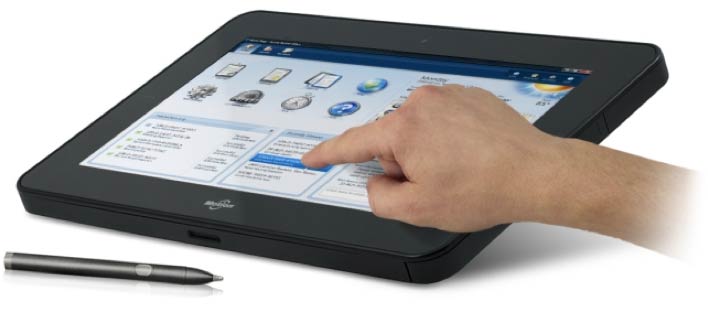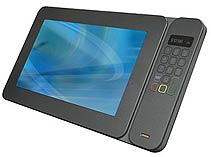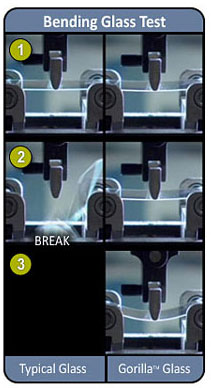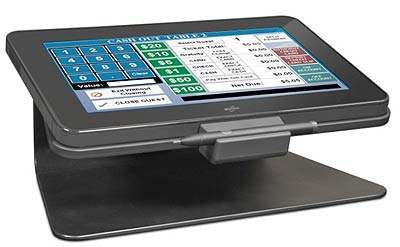|
Motion Computing CL900
Category pioneer Motion Computing presents an inexpensive lightweight, rugged, state-of-the-art Windows-based tablet computer with a high-res 10-inch display and dual input
(by Conrad H. Blickenstorfer -- view PDF version)
Motion Computing, one of the true pioneers in innovative tablet computers, introduced the Motion CL900 Rugged Tablet PC at the Consumer Electronics Show in Las Vegas on January 5, 2011. Motion developed this eminently practical machine specifically for markets that seek to implement the suddenly booming tablet form factor, but need an industrial-strength device that can handle drops and abuse as well as instant integration into existing IT infrastructures.

In search of the perfect tablet: difficult design decisions
 I am writing this on the eve of the 2011 CES where dozens of companies will introduce tablet computers, seeking to piggyback on the unexpected massive success of the Apple iPad. That doesn't seem too terribly difficult, but it is. No one but Apple has the iOS, yet everyone expects competing tablets to be as sleek, elegant and effortless as the iPad. That means competing tablets must use a different operating system, and having the right operating system is absolutely crucial to the success of a tablet.
I am writing this on the eve of the 2011 CES where dozens of companies will introduce tablet computers, seeking to piggyback on the unexpected massive success of the Apple iPad. That doesn't seem too terribly difficult, but it is. No one but Apple has the iOS, yet everyone expects competing tablets to be as sleek, elegant and effortless as the iPad. That means competing tablets must use a different operating system, and having the right operating system is absolutely crucial to the success of a tablet.
So unless you're HP and have bought Palm's WebOS, or you're Research in Motion and roll your own on top of the Unix-like QNX, it's either Android or Windows. Android is the hard-charging smartphone OS that Google is now trying to extend to tablets. Windows, well, Windows has to prove it can actually work on tablets, and by "work" I mean not just sort of work in certain vertical applications, but present the kind of truly compelling user experience that people now expect from tablets. That said, Windows still has 90% market share, and out there in corporate America where things need to work across the enterprise, that carries a lot of weight. So Motion chose to go with Windows 7.
The next big thing is making a tablet that won't break and that can be used wherever people work. The iPad is quite well made, but it's most definitely not rugged. And the iPad's screen is so mirror-like that it's often hard to see and use outdoors. And the iPad is touch only, but there are many applications that need a pen, too, because you can't really write with a finger or, if you use Windows, reliably tap on little boxes or move sliders. So you need a tablet that brings that elegant, effortless iPad experience into the field, but one that's tougher than the iPad, one that can be seen and used outdoors, one that can be used with a pen, and one that won't break the bank, because the iPad doesn't. Oh, and the new device must do all that with the look and feel of a cool iPad, and not one of those old Microsoft Tablet PCs that never really caught on.
That is a very, very tough assignment, but Motion Computing has been there before. Back in 2002 when Microsoft announced the Tablet PC, newcomer Motion cheekily took on tablet market leader Fujitsu, and prevailed. No, even Motion couldn't make the original Tablet PC a resounding success, but with singleminded dedication to their niche, and early adoption of all available new technologies, Motion succeeded in making good, useful tablets. And now they have a chance to really cash in by applying their decade-long experience in making, improving, and selling tablets.
So what has Motion cooked up with their new rugged tablet?
What's the new Motion tablet like? It looks like a wide-screen iPad, which in a way is too bad because Motion is perfectly capable of creating their own styles and designs, but right now, the iPad is it, and if you want to be part of the tablet wave, and distance yourself from those "old" tablets, you need to look like the iPad. For now at least. So the CL900 is a sleek, glossy tablet with a glass surface and minimal controls. It's a bit thicker than the iPad, but not by much. And though it's in an entirely different dimension as far as ruggedness goes, it doesn't weigh much more, tipping the scale at just two pounds, less than any netbook.
While a lot of the newly announced tablets have smallish 7-inch screens, Motion gave the CL900 a nice, big 10.1-inch LCD with 1366 x 768 pixel resolution. That's more than the iPad, and more than all of the early iPad copies. And, incidentally, it's also the resolution used on 720p HDTVs, making it perfect for HD playback.
The whole thing is based on one of Intel's new "Oak Trail" Atom processors, running at 1.5GHz and supposedly capable of full HD video playback and swiftly handling Windows 7, all at minuscule power consumption. This is not the place to go into Intel chip specifics, so suffice it to say that "Oak Trail" is Intel's System-on-Chip shot at a processor/chipset platform that will establish Intel as a force in the emerging tablet market (which it is not at this point). To read about Intel's plans with Oak Trail, check their release. This also ties into battery life where the iPad also set new standards with its 10+ hour battery life. Between the frugal Atom chip, Motion's power preservation magic, and a comparatively massive 43 watt-hour battery, Motion claims 8+ hours. Storage is via a 30GB solid state drive, with an optional 62GB version also available.

What did Motion use for touch? After all, a good part of the iPhone/iPad mystique is that light touch and the way you can use not just one, but two fingers to effortlessly zoom in and out. Multi-touch is clearly a resounding success, as evidenced by the fact that everyone is now trying to copy it. That didn't work well at first, but Android devices with capacitive multi-touch screens are now doing a good job at it. Motion implemented multi-touch on its formidable Windows 7-based J3500 tablet, using Wacom technology, and that worked surprisingly well (see my video demonstration on YouTube). So Motion has experience in making multi-touch work. Interestingly, though, the new CL900 uses n-Trig's DuoSense (see DuoSense page) technology. I've seen DuoSense at work in Samsung's little Galaxy Tab Android tablet, and it performed well (see Galaxy Tab review).
 Connectivity is always an issue, and one where the iPad also set the standard, although one where iPad users do it Apple's way, or no way. The Motion CL900 is more flexible here. There's a USB port, a micro-HDMI video port, an SD Card slot and also a heavy duty dock, something that Motion has been fine-tuning for many years now. There's 802.11a/b/g/n WiFi and BlueTooth, of course. And if you need 3G, there's the optional Gobi 3000 module that, unlike the current iPad's 3G, can connect and communicate with whatever carrier you choose. Also worth mentioning is that the CL900 offers additional expansion potential via yet-to-be-released peripheral modules (see picture to the right). And unlike the original iPad, the Motion CL900 can be had with a camera, two in fact. One faces the user for conference, the other points away for documentation. Connectivity is always an issue, and one where the iPad also set the standard, although one where iPad users do it Apple's way, or no way. The Motion CL900 is more flexible here. There's a USB port, a micro-HDMI video port, an SD Card slot and also a heavy duty dock, something that Motion has been fine-tuning for many years now. There's 802.11a/b/g/n WiFi and BlueTooth, of course. And if you need 3G, there's the optional Gobi 3000 module that, unlike the current iPad's 3G, can connect and communicate with whatever carrier you choose. Also worth mentioning is that the CL900 offers additional expansion potential via yet-to-be-released peripheral modules (see picture to the right). And unlike the original iPad, the Motion CL900 can be had with a camera, two in fact. One faces the user for conference, the other points away for documentation.
How rugged is it?
Motion didn't design their new CL900 to be an iPad killer or competitor. The whole point of this new tablet is trying to provide users in the field an experience that comes close to what they've learned to expect from their iPhones and iPads. And for that it must be something the iPad isn't. Rugged.
 Let's look at the specs. Motion quotes an operating temperature range of 41 to 110 degrees Fahrenheit. That precludes operation in freezers or arctic environments, but it is good enough for most outdoor deployments. Let's look at the specs. Motion quotes an operating temperature range of 41 to 110 degrees Fahrenheit. That precludes operation in freezers or arctic environments, but it is good enough for most outdoor deployments.
In terms of sealing, the CL900 carries an IP52 rating, where the "5" means it's pretty much dust-proof, and it's also protected from water spray onto its surface from angles up to 15 degrees. That's actually not very waterproof and most rugged devices carry at least an IP54 rating, but this is the current spec.
In the field, tablets get dropped, and so the CL900 is designed to survive 4-foot drops, which is about the height from which a tablet drops when you hold it in your hands. Motion also lists altitude (up to 15,000 feet) and humidity (8-80%) specs, but nothing about vibration and some of the more esoteric areas like EMI and such. Motion does provide, however, long lists of safety and regulatory requirements that the CL900 meets, and some is probably covered in there.
Another thing to be mentioned under ruggedness is Gorilla Glass, the funny-sounding super-tough surface from Corning that makes the display much more durable and scratch resistant. And from my own experience with it, I can add that it is very smudge-resistant, too, something that certainly comes in handy. The picture on the right shows a Gorilla Glass demonstration, and if you want to read more about Gorilla Glass, here's our coverage of Gorilla Glass.
So the Motion CL900 is quite tough and rugged, much more so than consumer tablets. And I am sure Motion thought about the many trade-offs between size, cost, weight and ruggedness long and hard before deciding on the CL900's specs. They have a decade's worth of experience listening to their customers to back up their decisions.
Will it all work?
The application potential for a ruggedized tablet such as the Motion CL900 is almost limitless. That's if it all works, if the decision to go with Windows 7 pans out, and if the digitizer manages to come close to providing an iPad-like experience.  If those hurdles can be negotiated, the significant advantage of ruggedness, fitting into existing Microsoft-based IT structures and programming, and Motion's channel and experience may well make this new tablet Motion's most significant product by far. If those hurdles can be negotiated, the significant advantage of ruggedness, fitting into existing Microsoft-based IT structures and programming, and Motion's channel and experience may well make this new tablet Motion's most significant product by far.
Motion CEO David Altounian puts it this way: "Motion's new CL900 will enable users to take advantage of connected applications, while also supporting uninterrupted productivity in remote or disconnected areas. We've combined our trademark rugged design and robust solution set with the connectivity and portability of a tablet that is designed and built for business."
How about price? That seems right, too. The CL900 will have a starting MSRP of under US$1,000, a veritable bargain for a ruggedized device that'll likely have a much lower total cost of ownership than consumer tablets.
For close to a year now, the iPad has owned the tablet market, fundamentally changing user expectations in the process. The coming days, weeks and months will show whether Apple's monster home run can be leveraged and expanded on, or if its magic is unique. Motion placed its bets with the CL900 and now it's off to the races.
Update May 11, 2011: Motion announced that the CL900 is available for order, starting at US$899, with a standard four-week lead time.
– Conrad H. Blickenstorfer
Motion Computing CL900 Specs:
| Added/changed |
Added 1/2011, updated 05/2011
|
| Type |
Rugged tablet computer
|
| Processor |
"Oak Trail" Intel Atom Z670 processor 1.5GHz |
| Chipset |
Intel SM35 Express |
| Graphics |
Intel GMA600 @ 400MHz |
| OS |
Windows 7 Home Premium or Windows 7 Professional |
| Memory |
1GB or 2GB 800MHz DDR2 |
| Expansion slots |
1 SD Card, 1 SIM |
| Display |
10.1" 1366 x 768 pixel wide-format LCD with LED backlight and Corning Gorilla Glass |
| Digitizer/Pens |
N-trig DuoSense/1 |
| Keyboard |
external option |
| Storage |
30 or 62GB SATA 2.0 Solid State Disk |
| Housing |
Aluminum-alloy internal frame |
| Temperature |
41 to 110 degrees Fahrenheit (5-43 degrees Celsius) |
| Drop |
4-foot drop per MIL-STD-810G |
| Humidity |
8 to 80% without condensation |
| Altitude |
Up to 15,000 feet operating |
| Enclosure Class |
IP52 |
| Safety |
AS/NZS 3260:1997 and 60950-1 (2nd Edition); FCC/ANSI C63.4; UL, CUL, CE (IEC/EN60950-1; 2009 +All); IEC/EN 60950-1 2nd Edition (2009); CAN/CSARSS-102; FCC OET65 Supplement C; ETSI EN 62311:2008; LVD (73/23/EEC); EU Directives 2002/95/EC, 2002/96/EC, 2006/66/EC and amendments; Substances of Very High Concern (SVHC) Article 59.1 of Reg No. 1907/2006 of the European Parliament /REACH; California Proposition 65; Technical Instructions for Safe Transport of Dangerous; Goods by Air (ICAO Doc #9284); Emergency Response Guidance for Aircraft incidents involving Dangerous Goods (ICAO Doc #9481) |
| Regulatory |
AS/NZS 3548:1995 Class B, 4268; AS/ACIF S042.1 and AS/ACIF S042.3 (WCDMA/HSDPA); AS/ACIF S042.1 and AS/ACIF S042.3 (GSM/EDGE); CAN/CSA ICES-003 Class B, RSS-210 Issue 7, RSS-132 and RSS-133 (1xRTT/EVDO); CENELEC EN 55022 Class B (CISPR22), 55024 (CISPR24), EN 61000-3-2, 61000-3-3; ETSI EN 301-893, 300-328, 301-489-1, 301-489-7, 301-489-17, 301-489-24, 301-511, 301-908; FCC Part 15 Subpart B Class B, 15 Subpart C (2.4Ghz), Subpart E (5Ghz), Part 22 H and Part 24 E (1xRTT/EVDO); R&TTE (89/336/EEC) and (99/5/EC) |
| Size |
10.9" x 7.1" x 0.6" |
| Weight |
2.1 pounds incl. battery pack |
| Power |
43 WHr Lithium-Ion ("up to 8 hours") |
| Communication |
802.11a/b/g/n WiFi, Bluetooth 3.0, combined audio in/out jack, dual array mics; optional Gobi 3000 integrated mobile broadband with GPS |
| Interface |
1 USB, video-out (micro-HDMI), power, dock, front-facing 1.3-megapixel camera, rear-facing 3.0-megapixel camera |
| Warranty |
1-year standard, multi-year options |
| Price |
starting at US$899 |
| Contact |
Motion Computing www.motioncomputing.com |
|



